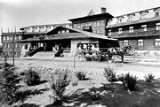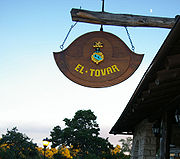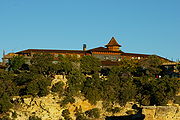
El Tovar Hotel
Encyclopedia
The El Tovar Hotel, also known simply as El Tovar, is a former Harvey House
hotel situated directly on the south rim of the Grand Canyon
in Arizona
, USA. The hotel was designed by Charles Whittlesey, Chief Architect for the Atchison, Topeka, and Santa Fe Railway and was opened in 1905 as one of a chain of hotels and restaurants owned and operated by the Fred Harvey Company
in conjunction with the Santa Fe railway. It is at the northern terminus of the Grand Canyon Railway
, which was formerly a branch of the Santa Fe. The hotel is one of only a handful of Harvey House facilities that are still in operation, and is an early example of the style that would evolve into National Park Service Rustic
architecture.
's 1903 visit to the canyon. During his visit Roosevelt said about the Grand Canyon:
The hotel, which had been under design since at least 1902, was built the next year and opened in January 1905. The Grand Canyon Game Preserve was established by Roosevelt's executive order in 1906, expanding protections granted by President Benjamin Harrison
in 1893. The Grand Canyon National Monument was proclaimed in 1908, and Grand Canyon National Park
was finally established by Congress in 1916.
The Santa Fe Railway initially planned for a relatively small hotel, but increased the size in view of increasing traffic to the Grand Canyon. The site was an area of 20 acres (8.1 ha) granted by the U.S. Government for use as a train terminal. The design was carried out by the railroad's architect Charles Whittlesey, of Topeka, Kansas
and was projected to cost $250,000 to build. Rejecting an initial plan to call it the "Bright Angel Tavern", the tradition of using Spanish names for Harvey hotels was continued for the new hotel. Since the name of the canyon's discoverer, García López de Cárdenas
, was given to an existing Harvey Hotel, the hotel was named after Pedro de Tobar (or de Tovar), who had reported rumors of a large river in the area, inspiring the Cárdenas expedition.
The hotel was built as a "destination resort
", providing a high level of comfort and luxury standing literally on the edge of the wilderness, 20 feet (6.1 m) from the rim of the canyon. The El Tovar was one of the first such hotels in national parks, part of a trend in which railroads would build large hotels in newly-accessible scenic locations like Yellowstone
and Glacier National Parks, stimulating tourist traffic, necessarily railborne, to those destinations. The railroads consciously employed architectural design in keeping with the image they wished to convey, a superficially rustic resort that provided a comfortable retreat.
Roosevelt returned to stay at the El Tovar in 1906, and again in 1913, writing a book about his 1913 trip.
 The eclectic character of the El Tovar's exterior is magnified on the interior, where the rustic Western-Swiss theme collides with elements of the Mission style
The eclectic character of the El Tovar's exterior is magnified on the interior, where the rustic Western-Swiss theme collides with elements of the Mission style
, accented with Arts and Crafts Movement
furnishings and southwestern Indian accents and motifs. The central "rotunda" of the lobby features Swiss-inspired cutout wood railings framed by peeled log posts, all varnished a dark brown, set against Southwestern-pattern carpets. A breakfast room was described in early promotional literature as "tastefully decorated in fifteenth-century style" while other areas had "trophies of the chase." Relatively few of these original decorations remain, with a greater present emphasis on Southwestern themes. Many of the original Arts and Crafts furniture pieces have been replaced or dispersed.
There were originally 103 guest rooms and 21 guest bathrooms, now 78 guest rooms, all with private bath. Rooms arranged on either side of central corridors through the wings. A large-scale renovation was completed in 1983, in which the original paired wood casement windows were replaced with dark brown anodized aluminum units, with decorative mullions on the single-light units.

on September 6, 1974. It was declared a National Historic Landmark
on May 28, 1987. The hotel is a major component of the Grand Canyon Village Historic District
, which encompasses the historic portions of the South Rim development, including visitor attractions designed by Mary Colter
, the Bright Angel Lodge and significant Park Service support facilities, typically designed in a consistent rustic style. The NRHP-listed El Tovar Stables
are nearby.
Fred Harvey Company
The origin of the Fred Harvey Company can be traced to the 1875 opening of two railroad eating houses located at Wallace, Kansas and Hugo, Colorado on the Kansas Pacific Railway. These cafés were opened by Fred Harvey, then a freight agent for the Chicago, Burlington and Quincy Railroad...
hotel situated directly on the south rim of the Grand Canyon
Grand Canyon
The Grand Canyon is a steep-sided canyon carved by the Colorado River in the United States in the state of Arizona. It is largely contained within the Grand Canyon National Park, the 15th national park in the United States...
in Arizona
Arizona
Arizona ; is a state located in the southwestern region of the United States. It is also part of the western United States and the mountain west. The capital and largest city is Phoenix...
, USA. The hotel was designed by Charles Whittlesey, Chief Architect for the Atchison, Topeka, and Santa Fe Railway and was opened in 1905 as one of a chain of hotels and restaurants owned and operated by the Fred Harvey Company
Fred Harvey Company
The origin of the Fred Harvey Company can be traced to the 1875 opening of two railroad eating houses located at Wallace, Kansas and Hugo, Colorado on the Kansas Pacific Railway. These cafés were opened by Fred Harvey, then a freight agent for the Chicago, Burlington and Quincy Railroad...
in conjunction with the Santa Fe railway. It is at the northern terminus of the Grand Canyon Railway
Grand Canyon Railway
The Grand Canyon Railway , is a passenger railroad which operates between Williams, Arizona, and Grand Canyon National Park South Rim.-Santa Fe Ownership:...
, which was formerly a branch of the Santa Fe. The hotel is one of only a handful of Harvey House facilities that are still in operation, and is an early example of the style that would evolve into National Park Service Rustic
National Park Service Rustic
National Park Service rustic, also colloquially known as Parkitecture, is a style of architecture that arose in the United States National Park System to create buildings that harmonized with their natural environment. Since its founding, the National Park Service consistently has sought to provide...
architecture.
History
The new hotel was built before the Grand Canyon was a formally protected Federal park, following on the heels of President Theodore RooseveltTheodore Roosevelt
Theodore "Teddy" Roosevelt was the 26th President of the United States . He is noted for his exuberant personality, range of interests and achievements, and his leadership of the Progressive Movement, as well as his "cowboy" persona and robust masculinity...
's 1903 visit to the canyon. During his visit Roosevelt said about the Grand Canyon:
I want to ask you to do one thing in connection with it in your own interest and in the interest of the country – to keep this great wonder of nature as it is now ...I hope you will not have a building of any kind, not a summer cottage, a hotel or anything else, to mar the wonderful grandeur, the sublimity, the great loveliness and beauty of the Canyon. Leave it as it is. You cannot improve upon it.
The hotel, which had been under design since at least 1902, was built the next year and opened in January 1905. The Grand Canyon Game Preserve was established by Roosevelt's executive order in 1906, expanding protections granted by President Benjamin Harrison
Benjamin Harrison
Benjamin Harrison was the 23rd President of the United States . Harrison, a grandson of President William Henry Harrison, was born in North Bend, Ohio, and moved to Indianapolis, Indiana at age 21, eventually becoming a prominent politician there...
in 1893. The Grand Canyon National Monument was proclaimed in 1908, and Grand Canyon National Park
Grand Canyon National Park
Grand Canyon National Park is the United States' 15th oldest national park and is located in Arizona. Within the park lies the Grand Canyon, a gorge of the Colorado River, considered to be one of the Wonders of the World. The park covers of unincorporated area in Coconino and Mohave counties.Most...
was finally established by Congress in 1916.
The Santa Fe Railway initially planned for a relatively small hotel, but increased the size in view of increasing traffic to the Grand Canyon. The site was an area of 20 acres (8.1 ha) granted by the U.S. Government for use as a train terminal. The design was carried out by the railroad's architect Charles Whittlesey, of Topeka, Kansas
Topeka, Kansas
Topeka |Kansa]]: Tó Pee Kuh) is the capital city of the U.S. state of Kansas and the county seat of Shawnee County. It is situated along the Kansas River in the central part of Shawnee County, located in northeast Kansas, in the Central United States. As of the 2010 census, the city population was...
and was projected to cost $250,000 to build. Rejecting an initial plan to call it the "Bright Angel Tavern", the tradition of using Spanish names for Harvey hotels was continued for the new hotel. Since the name of the canyon's discoverer, García López de Cárdenas
García López de Cárdenas
García López de Cárdenas, , is credited with the first European discovery of the Grand Canyon.- Life :Cárdenas was born in Llerena, Spain, son to Alonso de Cárdenas y doña Elvira de Figueroa and Maria García Osorio. He was the comendador of Caravaca.López de Cárdenas was conquistador attached to...
, was given to an existing Harvey Hotel, the hotel was named after Pedro de Tobar (or de Tovar), who had reported rumors of a large river in the area, inspiring the Cárdenas expedition.
The hotel was built as a "destination resort
Destination hotel
A destination hotel is a hotel whose location and amenities make the hotel itself a destination for tourists, rather than merely a convenient place to stay while traveling through or visiting the area for other reasons. Destination hotels are also called destination lodgings and sometimes...
", providing a high level of comfort and luxury standing literally on the edge of the wilderness, 20 feet (6.1 m) from the rim of the canyon. The El Tovar was one of the first such hotels in national parks, part of a trend in which railroads would build large hotels in newly-accessible scenic locations like Yellowstone
Yellowstone National Park
Yellowstone National Park, established by the U.S. Congress and signed into law by President Ulysses S. Grant on March 1, 1872, is a national park located primarily in the U.S. state of Wyoming, although it also extends into Montana and Idaho...
and Glacier National Parks, stimulating tourist traffic, necessarily railborne, to those destinations. The railroads consciously employed architectural design in keeping with the image they wished to convey, a superficially rustic resort that provided a comfortable retreat.
Roosevelt returned to stay at the El Tovar in 1906, and again in 1913, writing a book about his 1913 trip.
Description
The El Tovar was built from local limestone and Oregon pine. The lower portions of the building are mainly of log construction, yielding to lighter, smoother framed construction sheathed with planking for the upper levels. The roof is covered in shingles. The hotel is of variable height, with a two story central portion, a north wing three stories tall, and a four story south wing, the result of sloping land. A basement underlies the complex. The central section is 218 feet (66.4 m) long with a basement and main floor, with the long axis running roughly parallel with the canyon rim. The lobby, behind a broad entry veranda, extends to four stories topped with a turret with a pyramidal roof. The guest room wings extend from this central section at a shallow angle, with their top floors extending only partway, creating roof decks. The third floor exterior is treated as a mansard, with projecting dormers with shallow gables. The hotel's entrance is on the side away from the canyon, at a right angle to the railroad terminal directly across the street. The north wing runs toward the canyon, almost to its edge, ending in a porch overlooking the canyon. The south wing runs away from the canyon, ending in a semi-octagonal space once called the "grotto.". The dining room is to the rear of the lobby, with views of the canyon through its windows. Additions to this section of the building for kitchen and service areas have gradually expanded its footprint.
Mission style
Mission style may refer to the following:*Mission Style Furniture*Mission Revival Style architecture*American Craftsman, an architectural and design movement*Mission School, an art movement of the late 20th century...
, accented with Arts and Crafts Movement
Arts and Crafts movement
Arts and Crafts was an international design philosophy that originated in England and flourished between 1860 and 1910 , continuing its influence until the 1930s...
furnishings and southwestern Indian accents and motifs. The central "rotunda" of the lobby features Swiss-inspired cutout wood railings framed by peeled log posts, all varnished a dark brown, set against Southwestern-pattern carpets. A breakfast room was described in early promotional literature as "tastefully decorated in fifteenth-century style" while other areas had "trophies of the chase." Relatively few of these original decorations remain, with a greater present emphasis on Southwestern themes. Many of the original Arts and Crafts furniture pieces have been replaced or dispersed.
There were originally 103 guest rooms and 21 guest bathrooms, now 78 guest rooms, all with private bath. Rooms arranged on either side of central corridors through the wings. A large-scale renovation was completed in 1983, in which the original paired wood casement windows were replaced with dark brown anodized aluminum units, with decorative mullions on the single-light units.

Historic Designations
The El Tovar was placed on the National Register of Historic PlacesNational Register of Historic Places
The National Register of Historic Places is the United States government's official list of districts, sites, buildings, structures, and objects deemed worthy of preservation...
on September 6, 1974. It was declared a National Historic Landmark
National Historic Landmark
A National Historic Landmark is a building, site, structure, object, or district, that is officially recognized by the United States government for its historical significance...
on May 28, 1987. The hotel is a major component of the Grand Canyon Village Historic District
Grand Canyon Village Historic District
Grand Canyon Village Historic District comprises the historic center of Grand Canyon Village, on the South Rim of the Grand Canyon in Grand Canyon National Park, Arizona. The district includes numerous landmark park structures, many of which are National Historic Landmarks themselves, or are...
, which encompasses the historic portions of the South Rim development, including visitor attractions designed by Mary Colter
Mary Colter
Mary Elizabeth Jane Colter was an American architect and designer. As a child, Mary Colter traveled with her family through frontier Minnesota, Colorado and Texas in the years after the American Civil War. After her father died in 1886, Colter attended the California School of Design in San...
, the Bright Angel Lodge and significant Park Service support facilities, typically designed in a consistent rustic style. The NRHP-listed El Tovar Stables
El Tovar Stables
The El Tovar Stables at the south rim of the Grand Canyon were built about 1904, at the same time the nearby El Tovar Hotel was built, to house the animals used in general transportation around the park...
are nearby.
External links
- "Architecture in the Parks: A National Historic Landmark Theme Study: El Tovar", by Laura Soullière Harrison, at National Park Service.
- Great Lodges of the National Parks: El Tovar at PBS.org
- El Tovar Hotel, Grand Canyon National Park, Coconino, AZ at the Historic American Buildings Survey Historic American Buildings SurveyThe Historic American Buildings Survey , Historic American Engineering Record , and Historic American Landscapes Survey are programs of the National Park Service established for the purpose of documenting historic places. Records consists of measured drawings, archival photographs, and written...
(HABS)

